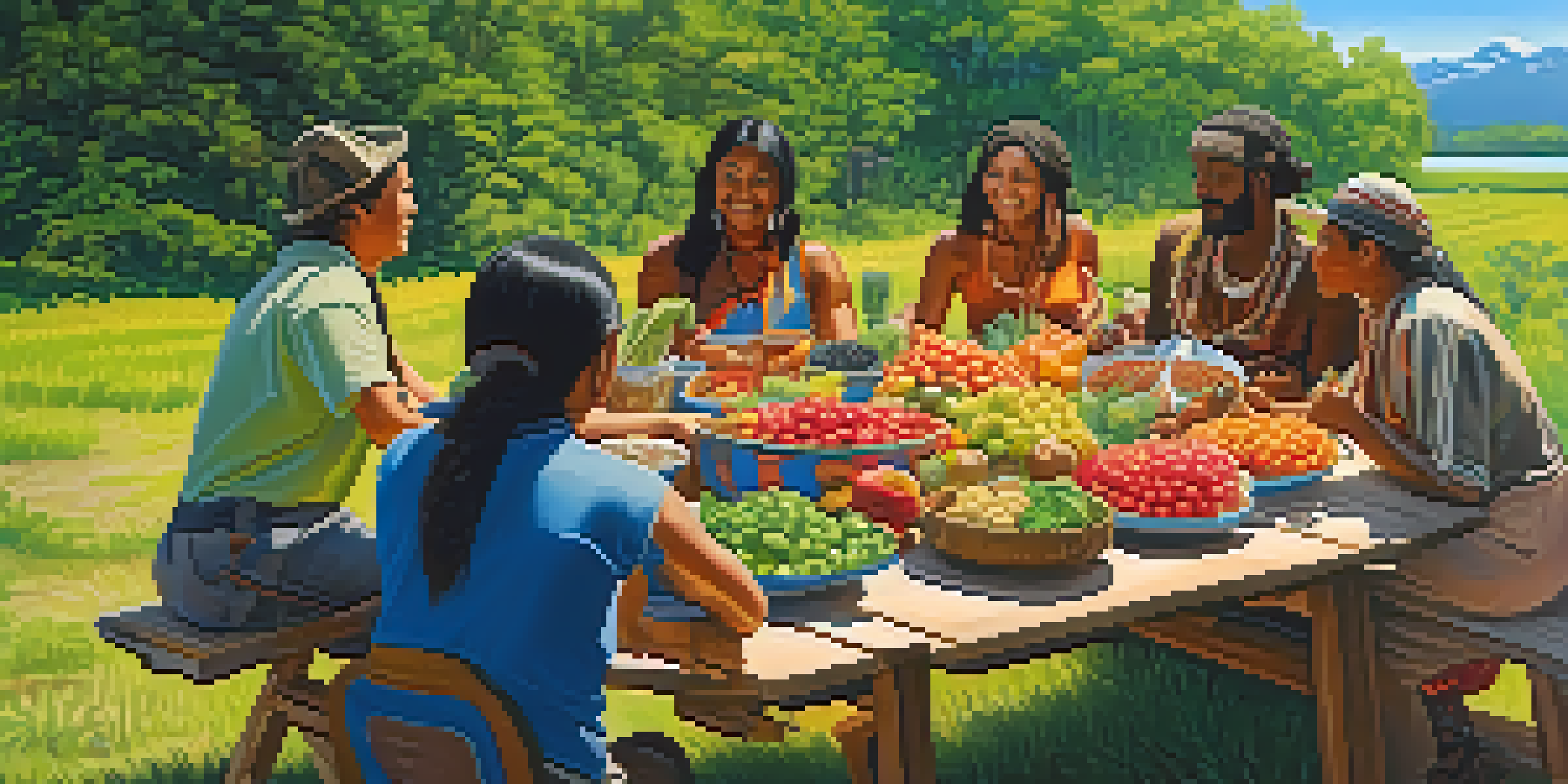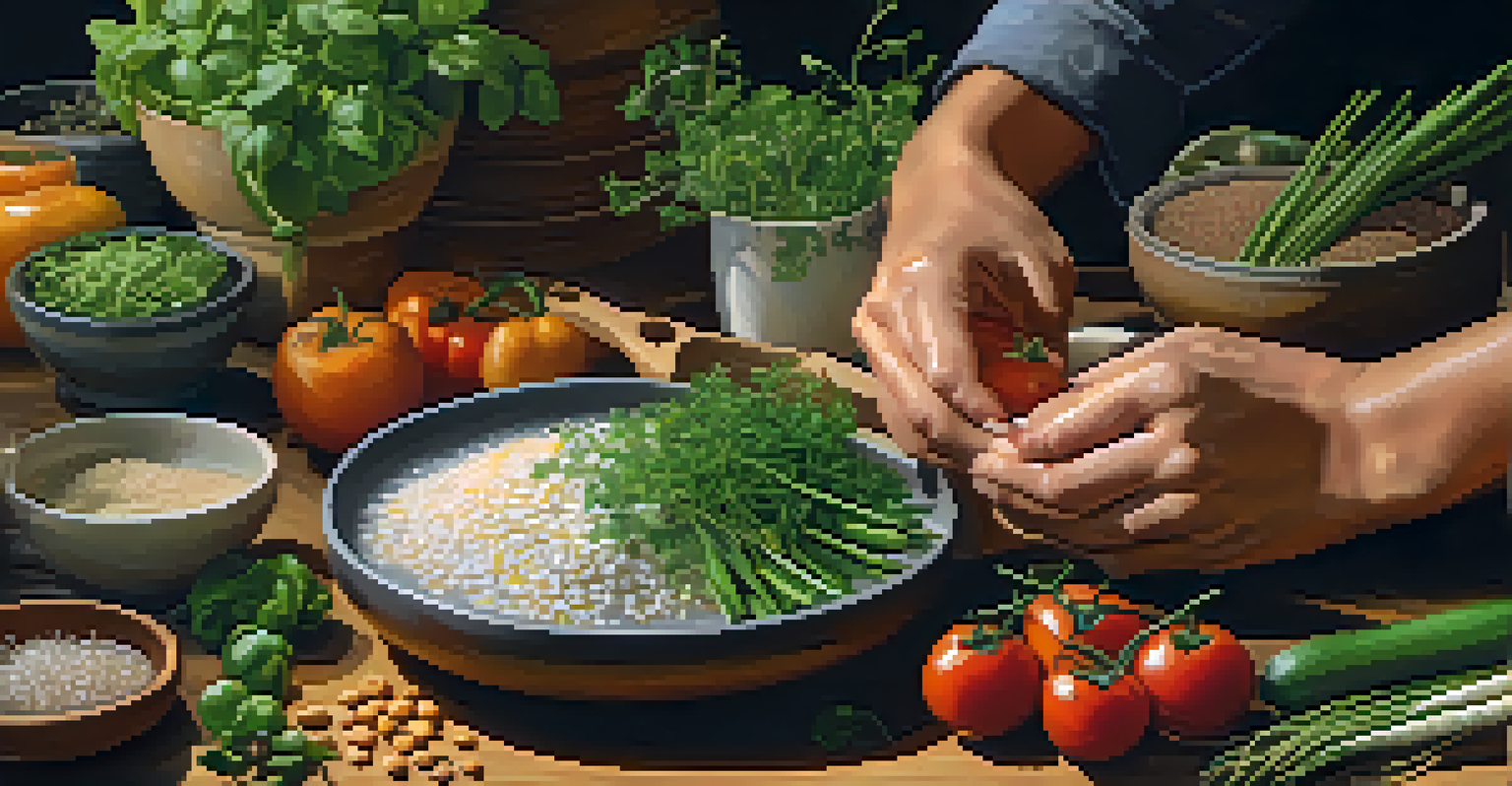Exploring Raw Food Traditions in Indigenous Cultures Worldwide

Understanding Raw Food and Its Significance
Raw food refers to uncooked, unprocessed plant-based foods that are often consumed for their nutritional benefits. Indigenous cultures have long embraced this approach, relying on their environment to provide fresh fruits, vegetables, nuts, and seeds. The significance of raw food goes beyond dietary preferences—it's about connecting with nature and respecting the land that sustains them.
Food is not just what we eat; it is a connection to our culture and our ancestors.
For many indigenous peoples, eating raw foods is a way to maintain traditional practices that have been passed down through generations. This connection to their heritage fosters a sense of identity and community, as meals are often shared among families and tribes. Additionally, raw foods are seen as a way to preserve the health of the body, aligning with holistic views of wellness.
What’s fascinating is that each culture has its unique raw food recipes, utilizing local ingredients. This diversity highlights how indigenous groups adapt their diets to their specific environments, creating a rich tapestry of food traditions that celebrate nature's bounty.
The Role of Seasonal Eating in Indigenous Cultures
In many indigenous cultures, food consumption is closely tied to the seasons. This practice not only ensures that food is consumed at its peak freshness but also aligns with the natural rhythms of the environment. Seasonal eating reflects a deep understanding of local ecosystems and the importance of sustainability.

For example, Native American tribes often harvest specific plants and fruits at certain times of the year, celebrating each season through festivals and communal gatherings. These traditions reinforce the connection between food and community, as families come together to prepare and enjoy raw dishes that honor their heritage.
Raw Food: A Cultural Connection
Raw food practices in indigenous cultures foster a deep connection to heritage, community, and the environment.
Moreover, seasonal eating encourages a varied diet rich in nutrients. By eating what is available at different times of the year, indigenous peoples are able to obtain a wide range of vitamins and minerals, supporting overall health and well-being.
Culinary Techniques: Preparing Raw Foods
Indigenous cultures have developed unique culinary techniques for preparing raw foods that enhance flavors and nutritional value. Techniques such as soaking, sprouting, and fermenting are commonly used to make raw ingredients more digestible and flavorful. These methods not only showcase culinary creativity but also demonstrate a deep knowledge of food science.
The land is our greatest teacher. It nourishes our bodies and souls.
For instance, some cultures utilize fermentation to preserve seasonal fruits and vegetables, creating tangy, probiotic-rich foods that are staples in their diets. This practice not only extends the shelf life of ingredients but also adds complexity to flavors, making meals more enjoyable and nutritious.
Additionally, the act of preparation often involves communal efforts, where families gather to share knowledge and skills. This not only strengthens familial bonds but also ensures that traditional techniques are preserved and passed down through generations.
The Health Benefits of Raw Food Diets
Raw food diets are often praised for their health benefits, including higher energy levels, improved digestion, and weight management. Indigenous cultures have long recognized these advantages, attributing their vitality and longevity to their natural, uncooked foods. Many traditional recipes focus on nutrient-dense ingredients that promote overall health.
For example, the consumption of raw fruits and vegetables is linked to lower risks of chronic diseases. Indigenous peoples who adhere to these diets often enjoy better heart health, reduced inflammation, and enhanced immune function. This connection between diet and health underscores the wisdom of their culinary traditions.
Seasonal Eating for Health
Eating seasonally allows indigenous peoples to enjoy nutrient-rich foods while maintaining a sustainable relationship with nature.
Moreover, the emphasis on fresh, whole foods allows for a diet rich in antioxidants and essential vitamins. By avoiding processed foods, indigenous cultures maintain a direct link to the earth's natural offerings, which supports their physical and mental well-being.
Cultural Rituals Surrounding Raw Food
In many indigenous cultures, raw food is intertwined with spiritual and cultural rituals. Meals are often prepared and consumed during sacred ceremonies, fostering a sense of community and gratitude. These practices emphasize the importance of honoring the land and the resources it provides.
For instance, in some South American tribes, the act of sharing raw foods during ceremonies symbolizes unity and respect for nature. The preparation of these meals often involves storytelling and passing down ancestral knowledge, reinforcing the bond between generations.
These rituals also serve as a reminder of the interconnectedness of life, where food is not just sustenance but a sacred gift. By incorporating raw foods into their spiritual practices, indigenous cultures celebrate their relationship with nature and emphasize the importance of sustainability.
Challenges Facing Indigenous Raw Food Traditions
Despite the richness of raw food traditions in indigenous cultures, many face significant challenges in preserving these practices. Factors such as modernization and globalization have led to the decline of traditional diets, as processed foods become more accessible and affordable. This shift threatens the survival of unique culinary practices and the health of communities.
Additionally, climate change poses a risk to food sources, impacting the availability of traditional ingredients. Indigenous peoples often rely on specific plants and animals that are sensitive to environmental changes, making their food systems vulnerable. These challenges highlight the importance of advocating for sustainable practices that honor indigenous knowledge.
Reviving Traditional Practices
There is a growing movement to revive indigenous raw food practices, emphasizing their cultural significance and health benefits.
Efforts are being made to revive and promote raw food traditions, with many communities seeking to educate younger generations about their culinary heritage. By fostering a sense of pride in traditional foods, these cultures can work towards preserving their unique identities and healthful practices.
Reviving and Celebrating Indigenous Raw Food Practices
In recent years, there has been a resurgence of interest in indigenous raw food practices, as more people recognize the benefits of these traditional diets. Chefs and culinary enthusiasts are exploring and sharing these recipes, helping to raise awareness about the rich culinary heritage of indigenous cultures. This movement not only celebrates the flavors of raw foods but also emphasizes their cultural significance.
Workshops and community events are being organized to teach traditional techniques and recipes, ensuring that knowledge is passed down to future generations. These gatherings foster a sense of community and encourage individuals to reconnect with their roots and the land. They also provide opportunities for storytelling, enhancing the cultural experience surrounding food.

By embracing and promoting indigenous raw food traditions, we can support the sustainability of these practices while also enriching our own diets. This revival not only honors the wisdom of indigenous peoples but also encourages a deeper connection to our food sources and a greater appreciation for the natural world.